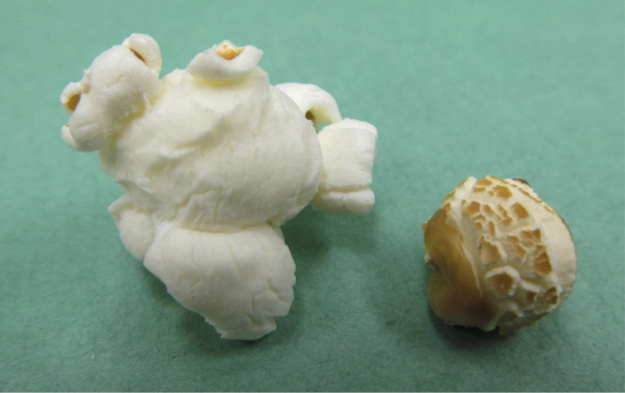Don Mercer
Moisture is an important component of most foods we eat. A fresh juicy apple contains about 85% water and is a tasty treat. If it loses moisture, its appeal diminishes. On the flip side, foods which are supposed to be dry, such as crackers, may lose their snap if they pick up moisture.
Many of us may never have associated the importance of moisture with popcorn – but it is critical to the process that changes a dense kernel of corn into a fluffy snack. Add some melted butter plus a bit of salt, and you have a movie-goer’s delight. Although it may seem like a simple process, there is a lot of science hidden beneath that shiny outer surface of a popcorn kernel.
Popcorn is actually a special variety of corn that has a long and storied history going back thousands of years to its origins in Peru. These kernels have an extremely rigid outer shell that surrounds an inner core of hard, dense starch. A small amount of water is trapped inside the kernel, as well. The outer shell of the kernel is so strong that even when the water is heated and converted to steam, it cannot escape. However, once the pressure builds sufficiently (to over 100 psi or 689 Pa), the force of the now super-heated steam is just too great, and the kernel splits open with an explosive force.
While the water is being heated, the starch inside the kernel is also undergoing some dramatic changes. With extreme temperatures as great as 180°C, the starch becomes gelatinised and softens appreciably. As it escapes from an area of high pressure inside the kernel to an area of much lower pressure outside the kernel, the hot gelatinised starch expands rapidly. When it cools, it sets into its familiar white fluffy form.
I recalled reading somewhere quite a long time ago, that popcorn requires both the water within the kernel, and the strong outer shell to pop successfully. Preparing an article like this gave me just the excuse to play around and put together an experiment of epic proportions.
The first step was to investigate the role of water in the popping process. I took a sample of popcorn and placed it in a drying chamber for three days at 50°C. During this time, the moisture content of the kernels decreased from just over 10% to slightly below 5%. Now, I was ready to check things out.
As my anticipation grew, I realised my personal inexperience with actually popping popcorn may put this experiment in jeopardy. This problem was easily remedied by soliciting the aid of someone who is an accomplished expert at making popcorn – my
wife, Jane. As she readied the hot-air popper, my apprehension grew. In true scientific form, I requested that we run a “control” sample of the original popcorn first. This would not only show what the popcorn should look like in its “normal” state, but it would also conserve my precious supply of dried kernels should anything go wrong from a technical perspective.
The kernels from the package popped beautifully with such force that they literally carried unpopped kernels with them as they were ejected from the popper. They were light and airy – just as they should be.
Next came the moment of truth. Shortly after the dried kernels were dropped into the hot-air popper, the sound of popping could be heard. I began to think that my drying efforts were in vain. However, it soon became apparent that the popped kernels were rather small, and the popping was not nearly as violent as in the “control” sample. In fact, the popping was so feeble that the popped kernels remained inside the hot-air chamber - there was not enough force to push them out. With all the heat, the small popped kernels began to brown. The smell of burnt popcorn filled the kitchen. At this point, the popper shut itself down as its internal temperature limit was exceeded. For me, the experiment was a complete success, and I was most thankful for Jane’s expertise. You can see the difference between the “normal” popcorn and the dried popcorn kernel in the photograph.

The popcorn kernel on the right was dried before popping
My next step was to investigate the role of pressure in the popping process. I must confess that this was a devastating failure due to technical difficulties. Initially, I tried to puncture holes in the popcorn kernels with a sharp push-pin. The kernels were just too tough for that simplistic approach. My fall-back position was to use an electric drill with a small bit. Holding a single kernel with pliers on a flat cutting board, and trying to drill a small hole was definitely frustrating. The drill bit tended to skate uncontrollably across the hard polished surface, rather than forming the desired small opening. It took several attempts before I accepted the harsh fact that there was a limit to how much effort should be expended on this quest for truth – especially since I needed a hundred or more kernels for the test.
Sadly, I cannot draw any conclusions about the inability of popcorn to pop when the kernel has been punctured. Perhaps in time, I will be able to address the problem and report some degree of success. In the meantime, there is comfort in knowing that moisture does indeed play an important role in the popping of popcorn.
Dr Don Mercer is Associate Professor in Food Science, Department of Food Science, University of Guelph, Guelph, Ontario N1G 2W1, Canada; e-mail: dmercer@uoguelph.ca
Permission to reproduce this article is greatly appreciated and acknowledged.
IUFoST Scientific Information Bulletin (SIB)
FOOD FRAUD PREVENTION